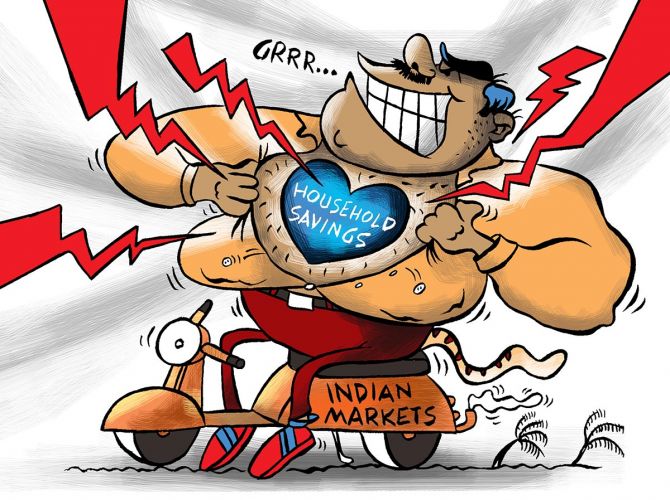'There's a misconception that all Rs 1 lakh crore will be spent immediately, leading to higher consumption of FMCG goods, travel, and vehicle purchases.'
'While some of this money will go toward consumption, not all of it will.'
'The impact depends on where people deploy their savings.'

"Looking at recent earnings trends, we could see another 5% to 7% correction in the index, which could mean 10% to 20% corrections in individual stocks. That could be an attractive level to start buying," independent market analyst Ambareesh Baliga tells Prasanna D Zore/Rediff.com.
Which sectors could benefit the most from this Budget?
One sector that stood out is nuclear power, though there aren't many listed entities to invest in. While smaller reactors were mentioned, the execution timeline is long. Only large power companies will likely participate.
Another focus area is the toy industry. Globally, it's a $400 billion market, with most production based in China. India is already manufacturing toys for export, and China Plus One-story is playing out in this sector.
However, because very few Indian toy manufacturers are publicly listed, this sector hasn't received much investor attention. Over the next decade, India could become a dominant player in toy manufacturing.
Given the recent sell-off in Indian equities, do you think valuations of broader market indices (Nifty 500, Nifty 750) are still stretched?
I wouldn't say valuations are stretched, but they are still expensive considering the expected slowdown for at least the next two quarters. Markets have corrected significantly, but valuations remain slightly high.
Do you expect further corrections in the markets?
Yes. Looking at recent earnings trends, we could see another 5% to 7% correction in the index, which could mean 10% to 20% corrections in individual stocks. That could be an attractive level to start buying.
Will mid-cap and small-cap stocks see larger corrections?
Yes. If large-cap stocks correct by 10% to 15%, mid-caps and small-caps could experience even deeper corrections.
The Economic Survey states that economic growth for the next fiscal year is expected to be between 6.3% and 6.8%, a gap of 0.5 percentage points.
Is this figure achievable? More importantly, will the government be able to contain the fiscal deficit at the budgeted 4.4%?
The projected growth of 6.4% to 6.5% seems achievable, especially since this estimate has already been revised downward. However, the bigger question is whether this is enough.
According to the Economic Policy document, India needs 8% growth over a prolonged period to achieve its long-term target by 2047. If we are at 6.5% now, reaching 8% anytime soon appears unlikely.
Does this mean the timeline for achieving 8% growth could get extended?
Yes, that's a crucial concern. Achieving 8% growth for at least a decade or longer is essential for the 2047 target of Viksit Bharat (making India a developed country). The question is whether this timeline will get pushed further.
Another factor is the rupee's depreciation. Given historical trends,unless we consider the past two to two-and-a-half years, when the rupee was relatively stable, depreciation has been a consistent trend. Given this history, continued depreciation is a possibility.
In the short term, can the government stick to its fiscal deficit target?
For the next year, holding on to the fiscal deficit target seems feasible. The government has made significant allocations to benefit the middle class and salaried individuals, but it has also balanced this by holding back on capital expenditure (capex). Additionally, subsidies are at a five-year low, which is a positive development.
How does the government expect growth to come from infrastructure and defense projects?
The government is relying on better execution of infrastructure, railway, and defense projects to drive growth. Last year, execution suffered, but this year, it is expected to pick up. Private participation through Public-Private Partnerships (PPP) and state-centre collaborations is also expected to contribute. However, since many of these projects involve multiple stakeholders, achieving timely financial closure and execution remains a challenge.
Would you say this Budget primarily targets the middle class and rural India?
Yes, this Budget clearly focuses on easing the burden on the taxpaying middle class while improving conditions in rural India.
Were you surprised by the tax relief of no tax up to Rs 12 lakh? What were your biggest surprises and disappointments in this budget?
The tax relief was expected. If it had not been included, it would have been a major disappointment. However, there was some debate over whether the limit would be Rs 12 lakh, Rs 12.75 lakh (with salary reductions), or closer to Rs 10 lakh.
The Rs 12 lakh exemption was higher than most expectations, leading to approximately Rs 1 lakh crore in tax savings. This was a pleasant surprise.
Is this Budget a 'middle-class-friendly' budget?
Yes, I would say this is an all-out Budget for the middle class and dual-income households.
What do you think was missing?
On the manufacturing side, I expected more incentives for China Plus One sectors. These sectors have the potential to compete with China, especially given global tariff policies like those introduced by Trump.
While this wasn't included in the Budget, India could still introduce measures outside the Budget to capitalise on these opportunities.
The Rs 1 lakh crore tax relief -- how much additional demand could it generate? Could it significantly boost GDP growth?
There's a misconception that all Rs 1 lakh crore will be spent immediately, leading to higher consumption of FMCG goods, travel, and vehicle purchases.
While some of this money will go toward consumption, not all of it will. The impact depends on where people deploy their savings:
- If spent on consumption, the multiplier effect will be moderate
- If used for purchases via financing (e.g., two-wheelers, four-wheelers), the multiplier effect is greater -- potentially 5x
- If saved in fixed deposits (FDs), the economic impact is lower
- If invested through SIPs, the impact is different but still positive
- If used to repay personal or gold loans, the effect on growth will be different
So, we can't assume the entire Rs 1 lakh crore will boost immediate consumption.
Disclaimer: This article is meant for information purposes only. This article and information do not constitute a distribution, an endorsement, an investment advice, an offer to buy or sell or the solicitation of an offer to buy or sell any securities/schemes or any other financial products/investment products mentioned in this article to influence the opinion or behaviour of the investors/recipients.
Any use of the information/any investment and investment related decisions of the investors/recipients are at their sole discretion and risk. Any advice herein is made on a general basis and does not take into account the specific investment objectives of the specific person or group of persons. Opinions expressed herein are subject to change without notice.
Feature Presentation: Ashish Narsale/Rediff.com











 © 2025
© 2025